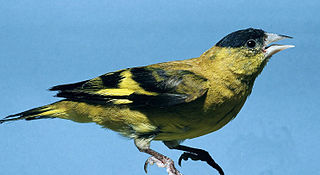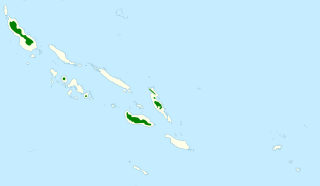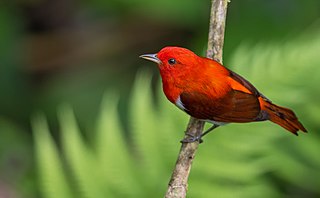
The chivi vireo is a small South American songbird in the family Vireonidae. It was formerly considered a subspecies of the red-eyed vireo. It is usually green to yellow-green in color with off-white underparts, and a gray crown. It has a whitish supercilium extending over its ear coverts, and its lores are dull gray in color. The chivi vireo has nine subspecies. It is found throughout most of northern, eastern and central South America, only being absent from southern Chile and southern Argentina. It inhabits multiple types of habitat across its range, and appears to adjust well to slightly disturbed habitat. The chivi vireo is mainly resident, but at least two of the subspecies inhabiting the south of its range are known to be migratory.

Carola's parotia, also known as Queen Carola's six-wired bird-of-paradise or Queen Carola's parotia, is a species of bird-of-paradise.

The Andean siskin is a species of finch in the family Fringillidae. It is found in Colombia, Ecuador, and Venezuela. Its natural habitats are subtropical or tropical moist montane forests, subtropical or tropical high-altitude shrubland, subtropical or tropical high-altitude grassland, and heavily degraded former forest.

The golden grosbeak, also known as golden-bellied grosbeak or southern yellow grosbeak, is a species of grosbeak in the family Cardinalidae. It is similar to, and has sometimes been considered conspecific with, the yellow grosbeak.

The Malagasy coucal or Madagascar coucal is a species of cuckoo in the family Cuculidae. It is found in Madagascar and in the Seychelles, where it occurs on Aldabra and was formerly present on Assumption Island and Cosmoledo. Its natural habitats are dense vegetation in subtropical or tropical moist lowland forests, mangrove forests, rough grassland, marshes and reedbeds.

The Cocos cuckoo is a species of cuckoo in the family Cuculidae. It is endemic to Cocos Island, an island in the Pacific Ocean which is part of Costa Rica.

The scaly-naped amazon, also known as the scaly-naped parrot, mercenary amazon, Tschudi's amazon, mountain parrot, or gray-naped amazon is a species of parrot in the family Psittacidae. It is found along the Andes in the northern part of South America. Its natural habitats are subtropical or tropical moist lowland forest and subtropical or tropical moist montane forest.

The Hispaniolan amazon or Hispaniolan parrot, colloquially known as cuca, is a species of Amazon parrot in the family Psittacidae. It is endemic to Hispaniola, and has been introduced to Puerto Rico. The main features that differentiate it from other amazons are the white forehead, pale beak, white eye-ring, blue ear patch, and red belly.

The red-fronted lorikeet, also known as the red-spotted lorikeet or red-rumped lorikeet is a species of parrot in the family Psittaculidae. It is found in northern New Guinea and the island of Biak. Its natural habitat is subtropical or tropical moist montane forests.

The pale mountain pigeon is a species of bird in the pigeon family Columbidae. It is endemic to the Solomon Islands archipelago, where it inhabits old-growth and secondary montane forest. It is a medium-size pigeon with an average length of 38 cm (15 in) and a weight of 310–385 g (10.9–13.6 oz). The head and neck are whitish-grey, the belly and lower breast are buffy-pink, and the vent and undertail coverts are pale grey. The upperparts are smoky-grey with darker fringes on the mantle and wing coverts. Both sexes look similar, but there can be large variation in individual appearance.

The mountain kingfisher is a species of bird in the subfamily Halcyoninae in the family Alcedinidae. Adult males are 21–24 cm (8.3–9.4 in) long, and have a rufous head and underparts, greenish-blue upperparts, a dark blue tail, and black flight feathers. They also have dark neck patches and loral patches. Females have dark crowns and the neck patches join at the nape. It is similar to the yellow-billed kingfisher, but can be distinguished by its larger size and a proportionally larger bill, along with a dark ridge along its culmen.

The scarlet-and-white tanager is a species of bird in the family Thraupidae. It is found in Colombia and northern Ecuador. Its natural habitats are subtropical or tropical moist lowland forests and heavily degraded former forest. The male is highly distinctive and has bright scarlet upperparts, darker red wings and undertail coverts, and white underparts with a scarlet median stripe running down the throat and belly. Females are patterned like the males, but are olive-brown instead of scarlet.

The smoke-colored pewee is a species of bird in the family Tyrannidae. The species is characterized by a uniform dusky-grey plumage.

The blue vanga is a bird species in the family Vangidae. It is in the monotypic genus Cyanolanius. It is found in Comoros, Madagascar, and Mayotte, where its natural habitats are subtropical or tropical dry forest and subtropical or tropical moist lowland forest.

The Grey-capped Warbler is a species of bird in the Cisticola family Cisticolidae. It is the only species in the genus Eminia. The Grey-capped Warbler is found in Burundi, Democratic Republic of the Congo, Kenya, Rwanda, South Sudan, Tanzania, and Uganda. It is a large, chunky, thin-tailed-warbler with a distinctive grey cap, a black band around its head, and a chestnut throat wrapping its neck. Grey-capped Warblers maintain a diet of insects and other invertebrates, including caterpillars, moths, grasshoppers, and mantids.

Archbold's newtonia is a species of bird in the family Vangidae. It is endemic to Madagascar. Its natural habitats are subtropical or tropical dry forests and subtropical or tropical dry shrubland. The birds have a greyish brown back and tail, with a rufous forecrown and a buffy white belly, throat, and undertail coverts. They have a conspicuous rufous eye-ring, accompanied with a black bill and pale yellow eyes. The species is sexually monomorphic, and there is no major difference between the sexes. There is no breeding plumage for the males.

The pale-footed swallow is a species of bird in the family Hirundinidae. It is found in the northern Andes, from Venezuela to Bolivia. It is monotypic.

The flame-faced tanager is a species of bird in the tanager family Thraupidae. It is endemic to South America and is found in the eastern Andes of Colombia, Ecuador, Peru and Venezuela. Its natural habitat is subtropical or tropical moist montane forests. It is a distinctive-looking species with black and opalescent green upperparts, opalescent green and buff underparts, and a deep red and yellow face. The subspecies lunigera lacks the deep red on the face, which is replaced with orangish-red.

The scaly-breasted woodpecker, also known as the scale-breasted woodpecker, is a bird species in the family Picidae. It is found in Bolivia, Brazil, Colombia, Ecuador, French Guiana, Peru, and Venezuela. Its natural habitat is subtropical or tropical moist lowland forests.

The orange-breasted trogon is a species of bird in the family Trogonidae. It is a colorful, sedentary species that inhabits the lower canopy of the lowlands and forest of southern China, southeast Asia, Borneo, Sumatra and Java.





















